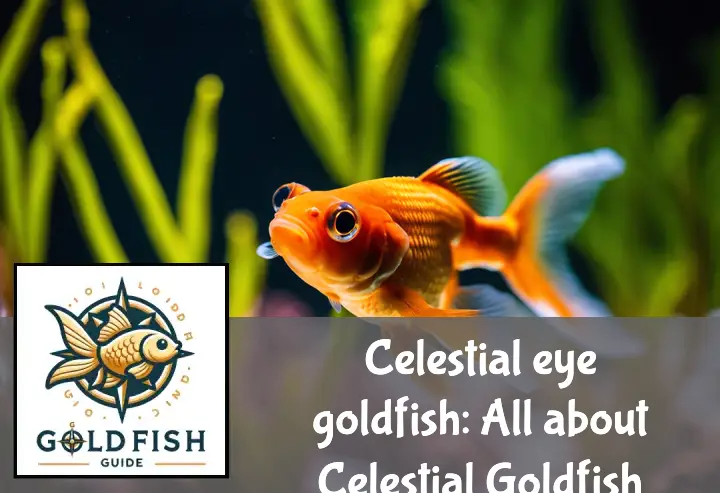Ever stumbled upon a goldfish that looks like it’s always gazing at the stars? Well, let me introduce you to the Celestial Eye Goldfish. This quirky little swimmer is known for its unique upward-pointing eyes, giving it an endearing, if somewhat comical appearance.
But there’s more to these little stargazers than meets the eye (pun intended!). They’re not just about their unusual look; they are fascinating creatures with a rich history and particular needs. So buckle up and keep reading about Celestial eye goldfish: All about Celestial Goldfish.
Key Takeaways
- Celestial Eye Goldfish, known for their upward-facing eyes, are a unique and popular aquarium pet.
- They require a balanced diet of pellets, vegetables, and occasional live food.
- These goldfish thrive in water temperatures between 65°F to 72°F with pH levels around 7.0.
- Due to their poor vision, they need a tank without sharp objects and with ample swimming space.
- Regular water changes and filtration are essential for their health.
- They can live up to 10-15 years with proper care.
What is a Celestial Eye Goldfish?
Well, let me tell you! The Celestial Eye Goldfish is a unique and fascinating aquarium fish. This little fella hails from the vast expanses of China and boasts some truly out-of-this-world features. It’s one of those goldfish species that’ll make you go “Wow, nature sure has a wild imagination!”
Origin and History
Our friend, the Celestial Eye Goldfish, has quite an interesting backstory. You see, it originated in China during the late 19th century. It was bred as an ornamental fish, much like many other ancient Chinese goldfish breeds.
The breeders were aiming for something special, something that would stand out in any freshwater aquarium. And boy, did they succeed! The result was this quirky little fish with eyes that gaze towards the heavens – hence its name.
Physical Characteristics
Now let’s talk about what makes this goldie so visually striking. First off, its size. A fully grown Celestial Eye Goldfish can reach up to 5 inches in length – not too big but definitely not small either!
Then there’s its coloration pattern. These fish are typically orange or red (though you might find some rare ones with different hues). Their bodies are roundish and slightly elongated – kind of like a plump teardrop.
Unique Features
But what really sets these guys apart are their eyes (I mean it’s in their name!). The eyes of the Celestial Eye Goldfish are large, protruding orbs that point upwards. This gives them a perpetual look of surprise and wonder.
This distinctive feature is unique among all other goldfish species. It’s like they’re constantly stargazing! But remember folks, while their upward-gazing peepers may be cute to us humans, it does limit their field of vision. So, be kind to your celestial buddies and keep their tanks free of sharp objects!
How to Care for a Celestial Eye Goldfish?
Caring for your Celestial Eye Goldfish involves more than just feeding it. It’s about creating the right environment, understanding their dietary needs, and being aware of potential health issues.
Ideal Tank Conditions
Your Celestial Eye Goldfish will thrive in a tank that mimics its natural habitat. A spacious tank is essential – think 20 gallons or more. The water temperature should be kept between 65 and 72 degrees Fahrenheit.
The pH level in the tank is also crucial. Aim for a range between 6.0 and 8.0 to keep your finned friend happy and healthy. Remember, maintaining these goldfish tank conditions can make all the difference!
Feeding Requirements
When it comes to grub, Celestial Eye Goldfish aren’t too picky. They’ll happily munch on flakes, pellets, or live food like brine shrimp and bloodworms.
But remember, overfeeding can lead to health problems! So stick to feeding them once or twice a day – moderation is key here folks! Trust me, your goldie will thank you for it.
Health Concerns and Lifespan
Like any pet, Celestial Eye Goldfish can face health issues. Common ones include swim bladder disease and fin rot. Regular check-ups with an aquatic vet can help catch these early.
And let’s talk lifespan – with proper care, these little guys can live up to 10-15 years! Now that’s what I call getting bang for your buck in the pet department!
Breeding Celestial Eye Goldfish
Breeding Celestial Eye Goldfish is a fascinating process. It’s not just about tossing two fish in a tank and hoping for the best. Nope, it involves understanding their mating habits, identifying their genders, and applying proper fish breeding techniques. So let’s dive into the world of Celestial Eye Goldfish reproduction.
Identifying Male and Female Celestial Eye Goldfish
When it comes to celestial eye goldfish sexing, there are a few telltale signs to look out for. Males usually develop tiny white spots on their gills during breeding season – these are called tubercles. Females, on the other hand, tend to have a rounder body shape when they’re full of eggs.
Behavioral signs can also be helpful in distinguishing goldfish genders. Males often chase females around the aquarium – not because they’re being mean, but because it’s part of their courtship dance! So if you see this happening in your tank, congratulations! You’ve successfully identified your aquarium fish gender.
Breeding Process
The actual breeding process of Celestial Eye Goldfish is quite an event! First off, you’ll need to create the right conditions for spawning. This includes adjusting the water temperature and providing plenty of plants or spawning mops for egg laying.
Once everything is set up, watch out for some typical goldfish mating behavior. The male will start chasing the female around the tank (remember that courtship dance we talked about?). If she’s ready to spawn, she’ll release her eggs onto the plants or spawning mops.
Now here comes the tricky part: fertilization. The male needs to swim over those eggs and release his sperm to fertilize them. And voila! If all goes well, you’ll soon have baby goldies swimming around your tank. Just remember, successful fish propagation requires patience and a keen eye for detail. So don’t be disheartened if it doesn’t work out the first time – keep trying!
Common Questions About Celestial Eye Goldfish
When it comes to Celestial Eye Goldfish, folks often have a few queries. They wonder if these fish are suitable for beginners and how they get along with other species. Well, let’s dive in and find out!
Are Celestial Eye Goldfish Good for Beginners?
If you’re a newbie in the aquarium world, you might be wondering about the beginner’s guide to celestial eye goldfish. Now, these little guys aren’t exactly what we’d call “easy care aquarium fish”.
Their unique eye structure requires some special attention. But don’t let that scare you off! With a bit of dedication and proper celestial eye goldfish maintenance, even beginners can manage.
Sure, they might not be the most beginner-friendly fish species out there. But hey, everyone loves a challenge, right?
Can Celestial Eye Goldfish Live with Other Fish?
Moving on to another common question – compatibility. Can your celestial buddy share its tank with other fish? The answer is yes…and no.
You see, when it comes to goldfish tank mates, not all fish make the cut. Some species might bully your celestial friend because of its slow swimming speed.
However, there are certain compatible fish species with goldfish that can coexist peacefully in a community aquarium with celestial eye goldfish. Just remember to do your homework before introducing any new roommates!
To Wrap Up
So, you’ve dived deep into the world of the Celestial Eye Goldfish, a creature as fascinating as a star-studded night sky. We’ve covered everything from its stargazing eyes to its toddler-like curiosity.
Remember, these little celestial beings require more than just a sprinkle of care. So, if you’re up for the adventure, why not welcome one into your aquatic family? Happy fish-keeping!



